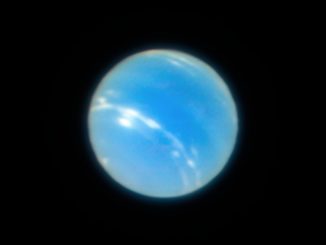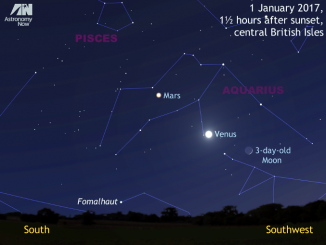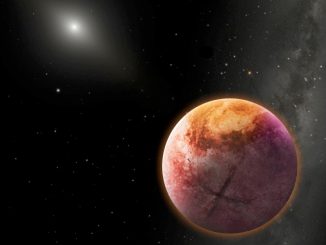
Neptune


See Venus farthest from the Sun, in conjunction with Neptune on 12 January
Thursday 12 January brings not only a full Moon, but also finds brightest planet Venus at its greatest easterly elongation from the Sun. By the time darkness falls in Western Europe and the UK, Venus also lies just 0.4 degrees from outermost planet Neptune, while Mars lies less than the span of a fist at arm’s length to their upper left.

See Mars and Neptune get close on New Year’s Eve & New Year’s Day
The young crescent Moon’s nightly motion from 31 December 2016 to 3 January 2017 carries it past dazzling planet Venus and first-magnitude Mars. A small telescope also reveals outermost planet Neptune, which passes just 0.02 degrees from Mars around 7h UT on 1 January, offering observers around the world a New Year’s Day treat.


Flying observatory SOFIA expanding frontiers in solar system and beyond
NASA’s Stratospheric Observatory for Infrared Astronomy (SOFIA) is a Boeing 747SP jetliner modified to carry a 100-inch diameter telescope to study the universe at infrared wavelengths that cannot be detected from ground-based observatories. SOFIA’s Science Cycle 5, which runs from February 2017 through January 2018, spans the entire field of astronomy from planetary science to extragalactic investigations.

Let the Moon be your guide to locating planet Neptune on 9 November
The penultimate 2016 occultation of Neptune by the Moon occurs on 9 November for observers in Western Asia, Eastern Europe and northernmost Africa. In Western Europe, the nine-day-old waxing gibbous Moon merely brushes by the outermost planet, but the pair will be close enough to be seen within the same field of view of a typical binocular from the UK.

Saturn’s moon Dione harbours a subsurface ocean
A subsurface ocean lies deep within Saturn’s moon Dione, according to new data from the Cassini mission. Two other moons of Saturn, Titan and Enceladus, are already known to hide global oceans beneath their icy crusts. Researchers believe that Dione’s crust floats on an ocean several tens of kilometres deep located 100 kilometres below the surface.

Origin of minor planets’ rings revealed
Chariklo is the largest confirmed centaur, a minor planet orbiting the Sun between Saturn and Uranus. In 2014, two rings were discovered around Chariklo. Soon after, scientists discovered that rings likely exist around another centaur, Chiron, but the origin of these rings remained a mystery — until now.

See the Moon hide planet Neptune on 15 September
Observers up for an extreme observing challenge may care to make an attempt at viewing the almost full Moon pass in front of planet Neptune soon after 8pm BST on Thursday, 15 September. The planet’s disappearance occurs at a low altitude in twilight for the British Isles, but can also be seen from a large swathe of Europe and western Russia.

Hunt for Planet 9 reveals extremely distant solar system objects
In the race to discover a proposed ninth planet in our solar system, astronomers are conducting the largest, deepest survey for objects beyond Neptune and the Kuiper Belt. Nearly 10 percent of the sky has been explored to date using some of the largest and most advanced telescopes, revealing several never-before-seen objects at extreme distances from the Sun.
